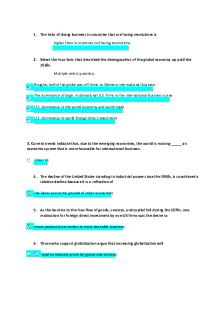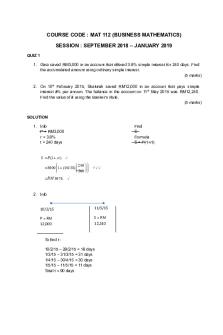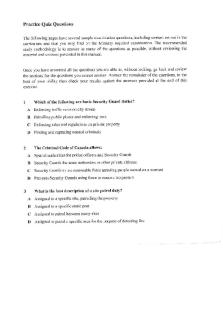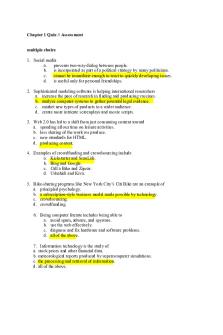Practice Quiz 1 PDF

| Title | Practice Quiz 1 |
|---|---|
| Author | noemie sauve |
| Course | Cell Biology and Metabolism |
| Institution | McGill University |
| Pages | 2 |
| File Size | 81.3 KB |
| File Type | |
| Total Downloads | 35 |
| Total Views | 221 |
Summary
practice quiz 1...
Description
BIOL 201 Winter 2019 Practice Quiz 1 1. Two proteins, A and B, bind non-covalently to form the complex AB according to the reaction A + B AB. Consider a solution of A and B that are in equilibrium with the complex AB. What is the reason that an individual AB complex dissociates? Select all that apply. a. AB dissociates because the dG of the dissociation reaction is negative b. AB dissociates because the dG* of the dissociation reaction is small c. AB dissociates because it is broken apart by collisions with other molecules d. AB dissociates because hydrogen bonds and electrostatic bonds are broken 2. Consider three proteins: a “slow” diffuser (A), a “moderate” diffuser (B), and a “fast” diffuser (C). The proteins have the following diffusion coefficients: DA = 4.5 um2/sec; DB = 12.5 um2/sec; DC = 24.5 um2/sec. For simplicity, we will treat their diffusion as one dimensional. At t = 0, you observe one protein of each species start diffusing from the same location in the cell (x = 0). After t = 1 sec, what is the position of the 3 particles? a. A at -3 um, B at +5 um, C at +7 um b. A at 3 um, B at -5 um, C at +7 um c. A at 1 um, B at -5 um, C at 1 um d. A at -5 um, B at +7 um, C at +5 um e. A and B are possible f. All of the above are possible 3. If an enzyme increases the probability of a reaction occurring by 10x, how much does it lower the dG* of the reaction? a. 10.0 kBT b. 2.3 kBT c. 0.1 kBT d. 0.43 kBT e. I do not have enough information to answer this question 4. Your lab mate is a pioneering mad scientist who is working on an obscure eukaryote. She is working on a gene that she believes is encoded by mitochondrial DNA and translated by mitochondrial ribosomes. She provides you with what she believes to be the coding sequence of the gene. Which of these experiments might provide some evidence that the gene is encoded by mitochondrial DNA and translated by mitochondrial ribosomes? Hint: some experiments might be less definitive than others yet still provide some evidence. Select all that apply. a. Purify the protein directly from the cells that produce it and determine the proteins’ physical properties (molecular mass, number of charged residues, etc). b. Express the protein in E. coli, purify it, and determine its physical properties (molecular mass, number of charged residues, etc).
c. Produce a fluorescent antibody to the protein and use it to determine whether the protein localizes to the mitochondria. d. Develop a fluorescent, complementary DNA or RNA strand that binds in a sequencespecific manner (an in situ hybridization probe) and determine whether it localizes to mitochondria. e. Purify the mitochondria from your lab mate’s cells and sequence their genome. f. Analyze the coding sequence itself and determine whether the gene has homologues in eukaryotes and/or prokaryotes. 5. In class, we focused on the regulation of step 3 of glycolysis, when phosphofructokinase converts fructose-6-phosphate to fructose-1,6-bisphosphate. Consider these facts about steps 1 and 2 of glycolysis. (Step 1) Hexokinase is allosterically inhibited by its direct product, glucose-6phosphate. (Step 2) The conversion of glucose-6-phosphate to fructose-6-phosphate by phosphoglucose isomerase is not regulated. Instead, the direction of the reaction is governed by equilibrium. Given this information, which of the following will slow down hexokinase? Hint: draw out the pathway of steps 1-3 of glycolysis. Select all that apply. a. A high concentration of citrate will slow down hexokinase b. A high concentration of glucose will slow down hexokinase c. A high concentration of ATP will slow down hexokinase d. A high concentration of fructose-2,6-bisphosphate will slow down hexokinase e. A high concentration of glucose-6-phosphate will slow down hexokinase 6. Why does ATP inhibit phosphofructokinase (PFK) differently than citrate? By “different”, I am referring to the shape of the reaction rate vs. inhibitor curve. a. Because ATP is an allosteric inhibitor and citrate is not. b. Because ATP is a substrate for PFK as well as an inhibitor. c. Because citrate is a direct product of PFK d. Because citrate has a higher affinity for its inhibitory site than ATP...
Similar Free PDFs

Sample Quiz #1 - Practice Quiz
- 2 Pages

Patho Practice Quiz 1
- 5 Pages

Chapter 1 - quiz practice
- 5 Pages

HW 1 - Quiz Practice
- 7 Pages

Practice Quiz 1
- 2 Pages

QUIZ 1 MAT112 Practice
- 2 Pages

Practice Quiz 1 - Exam
- 24 Pages

Practice Quiz 1
- 11 Pages

MGT2381 Chapter 1 Practice Quiz
- 6 Pages

American history quiz 1 practice
- 12 Pages

HV3 Practice Quiz #1 & 2
- 28 Pages

Pharm quiz 1 - good practice
- 15 Pages

Mitosis Quiz - Practice quiz
- 2 Pages
Popular Institutions
- Tinajero National High School - Annex
- Politeknik Caltex Riau
- Yokohama City University
- SGT University
- University of Al-Qadisiyah
- Divine Word College of Vigan
- Techniek College Rotterdam
- Universidade de Santiago
- Universiti Teknologi MARA Cawangan Johor Kampus Pasir Gudang
- Poltekkes Kemenkes Yogyakarta
- Baguio City National High School
- Colegio san marcos
- preparatoria uno
- Centro de Bachillerato Tecnológico Industrial y de Servicios No. 107
- Dalian Maritime University
- Quang Trung Secondary School
- Colegio Tecnológico en Informática
- Corporación Regional de Educación Superior
- Grupo CEDVA
- Dar Al Uloom University
- Centro de Estudios Preuniversitarios de la Universidad Nacional de Ingeniería
- 上智大学
- Aakash International School, Nuna Majara
- San Felipe Neri Catholic School
- Kang Chiao International School - New Taipei City
- Misamis Occidental National High School
- Institución Educativa Escuela Normal Juan Ladrilleros
- Kolehiyo ng Pantukan
- Batanes State College
- Instituto Continental
- Sekolah Menengah Kejuruan Kesehatan Kaltara (Tarakan)
- Colegio de La Inmaculada Concepcion - Cebu


